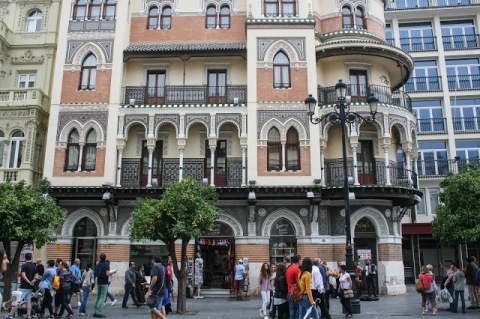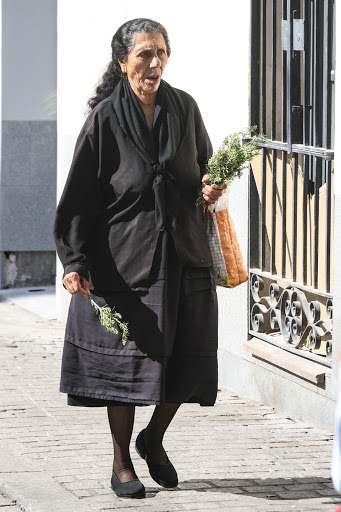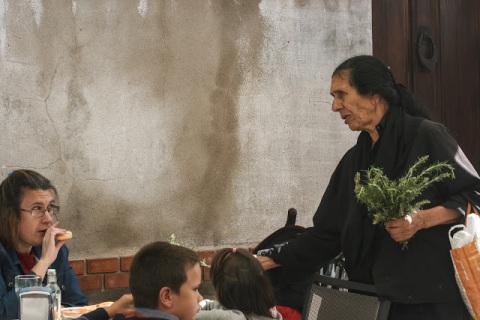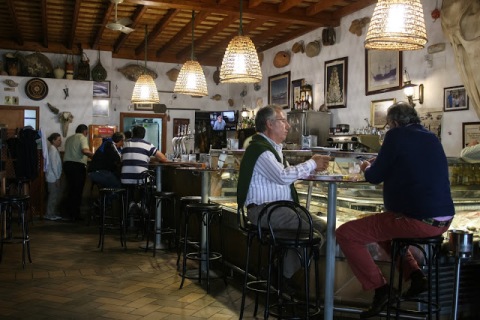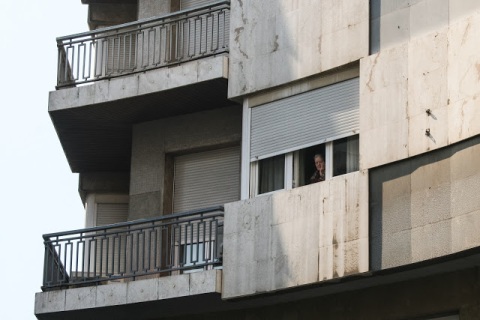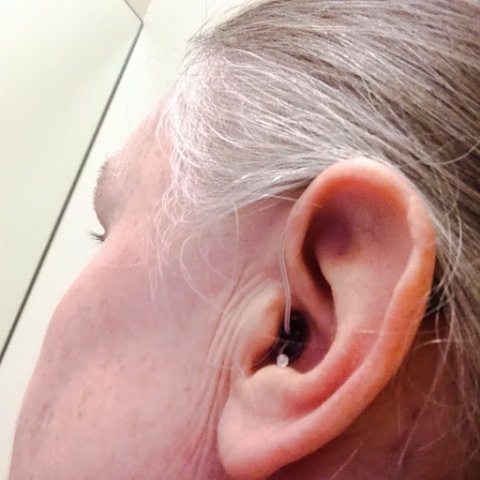Sweet and Sour Red Cabbage
June 16, 2016
Here is another winning recipe. It has been making the rounds among my sisters. We all like it. It uses red cabbage, which up until now I rarely bought. The bacon is the secret ingredient that adds a lot of flavor. I didn’t have much bacon on hand, so I added some ham as well. Yummy.
Sweet and Sour Red Cabbage
Cut 1/4 lb bacon into pieces and fry.
Add to the drippings a chopped onion and one small red cabbage, sliced thinly.
Saute until limp. While the cabbage is cooking, mix together in a small bowl:
1/4 c. vinegar (I used apple cider vinegar)
1/4 c brown sugar
1/2 tsp salt and pepper
Pour over cabbage and cook for an additional 15 – 20 minutes.
Enjoy!
People-Watching in Spain
October 27, 2015
“There are few things more delightful than to have nothing to do in a strange city and enough money to do it pleasantly, to sit and watch people and to wonder about them . . . The Spaniards can sit for hours just talking, or, if alone, doing nothing, with the mind’s engine shut off, just coasting pleasantly. This immobility is a wonderful gift, like the ability of a dog or a cat to go to sleep at any time.”
— H. V. Morton, A Stranger in Spain
“Happy, happy Spain, where there I always time to sip coffee and where to be busy is not a virtue.”
— H. V. Morton, A Stranger in Spain
When you travel like a tourist spending at most three or four days at a single destination, and especially when you don’t speak the language, it is difficult to penetrate the culture or have meaningful connections with the locals. When you sightsee at the major, must-see sites, you mix mostly with lots of other tourists. That is why I get a little thrill when I notice a slice of real life, individuals and families going about their business in their home towns and paying scant attention to camera-wielding intruders.
Of course, the locals might be enjoying some of their city’s treasures along with the tourists. Sometimes it is hard to tell them apart. But I bet those hundreds of people taking selfies were tourists busy documenting that they were HERE.
The major tourist areas also seemed to attract the “rosemary ladies,” who solicited donations in exchange for a sprig of rosemary.
It is fun to people watch and speculate about the lives of those who cross your path. Everywhere in Spain, elderly women walk arm-in-arm with a middle-aged companion. Are they mothers and daughters or daughters-in-law? Why are there seemingly more elderly women than men? Isn’t it wonderful that they still get out and walk the streets for shopping or their daily constitutional?
Or is this just a tradition, the multi-generational social outings for women of a certain age? (After all, even Picasso sketched two women walking. “Walking” by Picasso, 1899, from the collection of the Picasso Museum, Barcelona:)
There weren’t as many smokers as I expected, but we did notice higher-than-usual numbers of women in Madrid who were smoking on the streets.
And cell phones are ubiquitous, just as they are in the States.
Men seemed to gather in bars.
“It is a truism that Spaniards believe there is nothing more important than family life. In fact, they would probably rather show allegiance to any kind of family than to the State. For most Spaniards, the need, outside family, is met by the local bar, a place where one might spend at least an hour a day with friends.”
— Miranda Franca, Don Quixote’s Delusions: Travels in Castilian Spain
This family was dressed to the nines for a restaurant lunch in Triana:
“The only people in Spain more powerful than the mothers are the grandmothers.”
— H. V. Morton, A Stranger in Spain
And kids and teens in Spain are like kids and teens anywhere.
Here are a few more photos capturing the ordinary life and people of Spain:
Crows, Black as Coal
April 18, 2015
“They must have been swimming in midnights of coal mines somewhere.”
— Carl Sandburg
Fa La La La Caw
December 25, 2014
Wordless Wednesdays: 12 Views of Crows
December 10, 2014
Turkey Day
November 27, 2014
Today I quote the words of Benjamin Franklin, who defended the respectability of the turkey in a letter to his daughter Sarah in 1784:
“For my own part, I wish the bald eagle had not been chosen as the representative of our country; he is a bird of bad moral character; he does not get his living honestly; you may have seen him perched on some dead tree, where, too lazy to fish for himself, he watches the labor of the fishing-hawk; and, when that diligent bird has at length taken a fish, and is bearing it to his nest for the support of his mate and young ones, the bald eagle pursues him, and takes it from him. With all this injustice he is never in good case; but, like those among men who live by sharping and robbing, he is generally poor, and often very lousy. Besides, he is a rank coward; the little kingbird, not bigger than a sparrow, attacks him boldly and drives him out of the district. . .
I am, on this account, not displeased that the figure is not known as a bald eagle, but looks more like a turkey. For in truth, the turkey is in comparison a much more respectable bird, and withal a true original native of America. Eagles have been found in all countries, but the turkey was peculiar to ours . . . He is, besides, (though a little vain and silly, it is true, but not the worse emblem for that,) a bird of courage, and would not hesitate to attack a grenadier of the British guards, who should presume to invade his farmyard with a red coat on.”
Happy Thanksgiving!
Improbable and Preposterous Snowdrops
February 6, 2014
“Little bulbs that would be overlooked in the peak season have their day. The snowdrops are improbable if not preposterous.”
— Beatrix Potter, from Beatrix Potter’s Gardening Life by Marta McDowell
It turns out that Beatrix Potter loved snowdrops and often mentioned them in her letters, but she seldom painted them. I realize as I try to sketch and paint snowdrops that I don’t know how to paint white-colored things!
My Further Adventures in Hearing
January 14, 2014
My Further Adventures in Hearing: Adjusting to Wearing Hearing Aids
My 30-day trial period has ended, and I will be keeping my hearing aids. My adjustment hasn’t been too rough. I still keep the volume at 2 rather than 3 most times, but the startling crisp background sounds (which sound like crackling cellophane) have started to fade to a more bearable level. I still laugh when I hear radio frequencies recalibrated to lower levels because the “s” still sounds like “sh,” and you would be surprised how often the “s” is included in words. This compression distortion is most noticeable when I listen to the radio – less so in face-to-face conversations. My audiologist says that eventually my brain will hear a more normal “s” sound.
I wanted to give this update because so many of you commented on my December 12th post about getting hearing aids. I was helped immensely by your support, well wishes, and by your helpful tips and insights about the adjustment period I was experiencing. According to the Hearing Loss Association of America, “Nearly 17% of all Americans report a hearing loss, including a third of all individuals over the age of 65.” Some of you wear hearing aids or have close friends and family members who wear them. Others know first hand the impact of communicating with hearing-impaired people, some of whom are reluctant to take the plunge and get hearing aids. So all of your comments were appreciated.
It’s too bad that hearing aids are imperfect instruments. If the clarity I wanted was immediately apparent, then I would need no extra incentive to keep wearing the hearing aids. But the improvement to my hearing people and conversations is not that noticeable to me, perhaps because my hearing loss is at high frequencies and most people have nicely modulated voices in the lower registers. So I had to think seriously about the cost vs. benefits for me. And in the end, I decided that I wanted to do everything that was in my control to hear better because not hearing can be isolating. In the long term, as I expect my hearing loss to become more pronounced, I will have already adjusted to wearing hearing aids. So I remain committed to wearing these devices.
Here are some of my thoughts and impressions after 30+ days wearing hearing aids:
The world is an incredibly noisy place. When my audiologist reviewed the software that tracked how hard my hearing aids had been working, she saw that I was in quiet environments only 10- or 15-percent of the time. Most of my life is lived in moderately noisy places. It is true that we can hear freeway traffic from our home and that our old appliances hum along at an unquiet decibel level, so even when I am at home alone I am subjected to noise. You might think that a library workplace would be quiet, but it is filled with the sounds of babies crying, toddlers throwing tantrums, kids sliding chairs and stools to the checkout stations, date due slips chugging out of the receipt printers, sirens and street traffic, etc.
One of the advantages of hearing loss is the serenity of living in a world of subdued and muted background noise. I lost this quieter existence when I started wearing hearing aids. While the improvements to hearing conversations is not immediately apparent, I have experienced improvements in hearing background noises. My hearing aids can and do decrease general background input and hone in on a single voice. This happens automatically and my audiologist tells me that this feature has been working. I do feel more confident listening to patrons at the Circulation Desk at my library.
The brain is as much a hearing organ as the ear. Much of the adjustment to hearing aids is the brain adapting to hearing certain sounds again. At times I felt like I had sore inner ears, which my audiologist called “hearing fatigue.” It makes me wonder how often my old brain simply tuned out because it was struggling too hard to hear. Initially, I felt like my brain was over stimulated. Over time, I expect that my brain will once again filter out some of the inessential background sounds.
I quickly adapted to hearing the sound of my own voice through the hearing aid microphones, and it no longer sounds odd.
It’s not just about me. One of my readers sent an email reminding me that people don’t just get hearing aids for themselves, but also to make it easier for family and friends to communicate without so much of a struggle. It can be frustrating to have to continually repeat oneself.
Unfortunately my husband sometimes gets short shrift because after wearing my hearing aids all day at work, I usually take them off when I get home. I expect that over time I will feel more comfortable wearing them for longer and longer periods and take them out only when I get ready for bed.
When should I wear my hearing aids? I started out committed to wearing my hearing aids all day every day. But then for the past week, I neglected to wear them on my days off when I was home alone. I’m not sure this is a good idea. On Sunday when I started work at 8:30 a.m. I realized suddenly that I had forgotten to put my hearing aids in. That hadn’t happened before. If I get in the habit of putting them in every day after my morning shower, then I will lower the risk of not having them when I need them.
And I just had my first dream (nightmare) about losing my hearing aids!?! Maybe this comes with the territory, like dreams about not finding your locker when you were a student. Aargh!
Why are hearing aids so expensive? In this day and age, when you can get smart phones, iPads, tablets, and notebooks with miraculous computer capabilites for $1000 or less, why does it cost $5700 for two hearing aids that are imperfect technologies at best? This is a mystery to me. Perhaps Apple or Microsoft should get in the hearing aid business and drive the prices down.
Why aren’t hearing exams and hearing aids covered by insurance or Medicare? I believe that progressive, age-related hearing loss is as much of a medical issue as arthritis or diabetes, and therefore should be covered by insurance and Medicare. The Hearing Loss Association of America says that “Hearing loss is not a benign condition: recent studies reveal a linkage between untreated hearing loss and dementia, a greater incidence of balance problems and falls, and a greater incidence of stress-related diseases like diabetes and heart disease.” The high cost of hearing aids make them unaffordable for many Americans, and that is deplorable.
The Help Extend Auditory Relief Act of 2013 (HR 3150) would help change the law so that Social Security’s Medicare coverage would cover hearing tests and hearing aids. As far as I can tell, the bill is still in committee. I decided to express my support for this bill to my Congressman in a letter. (You can find a sample letter at the above link to the Hearing Loss Association of America.) Change will not happen unless people advocate for it.
Other Adventures in Hearing. When I went to a movie theatre over the holidays, I asked to use one of the devices they had for hearing-impaired people. It was like an oversized pair of eyeglasses that showed subtitles running across the bottom of the lenses. I thought it worked great, even if my ears were weighted down by my hearing aids, my eye glasses, and then the movie theatre’s special glasses!
In a few weeks I will be attending a seminar at work, and I asked to try out the library’s portable telecoil equipment. My hearing aids (and most newer models) include a telecoil feature. When I turn it on, I will hear the speaker’s voice streamed directly from his/her microphone to my ear buds instead of trying to pick up his/her voice from an echoey, large room filled with ambient sounds. For this technology to work, the room must be looped, or the listener must wear a portable loop around the neck. Here in Seattle, there is an organization called Let’s Loop Seattle that advocates for the installation of loops in public buildings, churches, theatres, auditoriums, even public transit.
I’m encouraged by the technologies available to me to help me hear better. I do believe that hearing loss is a social issue, and that it is appropriate for communities and government to help hearing-impaired people. And it is up to me to take advantage of the help that is available. I’m grateful.
Branching Out
November 15, 2013
Squash Wonton Ravioli
September 27, 2013
I had LOTS of wonton wrappers left after making dessert, so I decided to use the rest in an autumn-inspired ravioli. For the filling, I used half of a golden acorn squash and half of a carnival squash, baked until soft and then mashed. I added salt, some leftover sage pesto (from my Three Sisters recipe), sautéed baby bella mushrooms, and sautéed onion and garlic. I baked the ravioli rather than boil them, as I liked the slightly crispy texture with the soft filling. Served with tomato sauce garnished with feta cheese. Delicious!






